#ellen bepp
Text
623 ~ Part 1
623 East 68th Street: The Most Iconic Address on Television

THE PEOPLE of 623
~ THE LANDLORDS ~

#1) Fred & Ethel Mertz, 3C
In 1948, former vaudevillians Fred and Ethel Mertz (played by William Frawley and Vivian Vance), bought a four-floor New York City brownstone at 623 East 68th Street. They operate it as an apartment building. The building is in Ethel’s name only! The childless couple resides in apartment 3C.

Coincidentally, the year after Fred and Ethel bought the building, in real life an unrelated new TV show was airing titled “Apartment 3C”. It dealt with a married couple living in a Manhattan apartment building. Just like Lucy and Desi, the actors were married in real life. Writing about the show in 2022, their daughter said:
“Apartment 3C” was no “I Love Lucy” ~ J.G. Summers
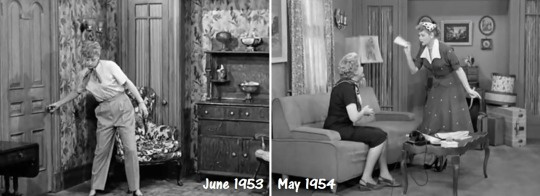
In “Lucy Wants New Furniture” (1953), there is a door in that wall that leads to the Mertz kitchen and back door, although every other time we see the Mertz living room, the kitchen door is on the right, not the left, and there is a window where the door was! This was to accommodate the gag of Lucy running from her kitchen to the Mertz’s.

At the end of the episode, the redecoration is such a disaster that the Ricardos end up giving the Mertzes their furniture and buying all new for themselves.
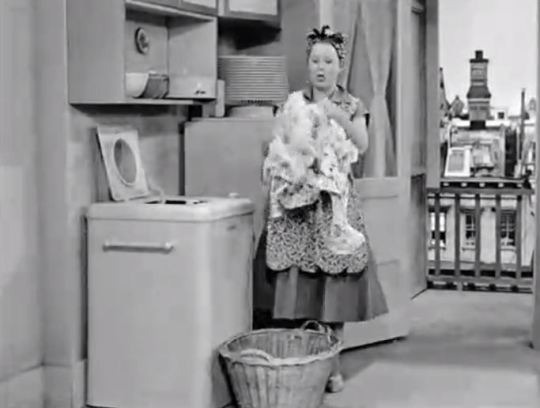
The only time we see the Mertz kitchen is in “Never Do Business with Friends” (1953).
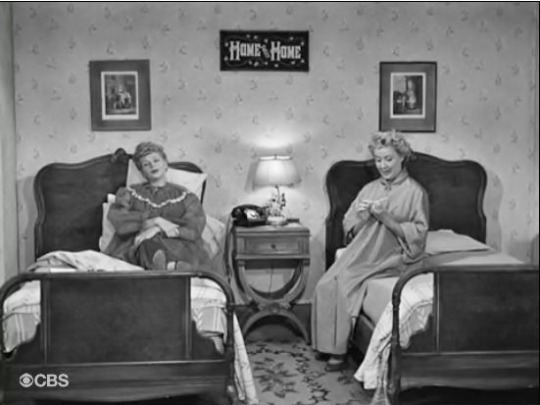
The only time we see the Mertz bedroom is in “Vacation for Marriage” (1952). Naturally they have single beds! [There’s a reason why they are childless!]
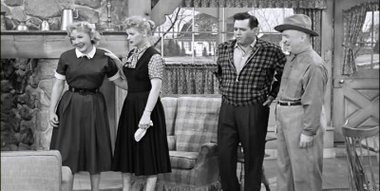
When the Mertzes move to Westport to live in the Ricardo’s guest cottage, the Mertzes retain ownership of the building, although they put the day-to-day running of the building (except for the collection of rents, that is Fred’s domain) in the hands of Mrs. Trumbull’s sister, a character we never see or even learn her name.
~ THE TENANTS ~
#2) Lucy & Ricky Ricardo, 4A
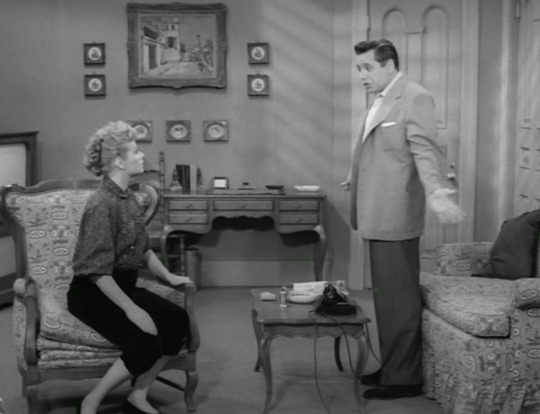
Lucy McGillicuddy and Ricky Ricardo (Lucille Ball and Desi Arnaz) moved to 623 shortly after they were married. He was a bandleader and she was a housewife with showbusiness aspirations.

On August 6, 1948 (Lucille Ball’s real-life birthday), they moved to an apartment building recently purchased by the Mertzes. Their first apartment was 4A. The rent was $105 a month.
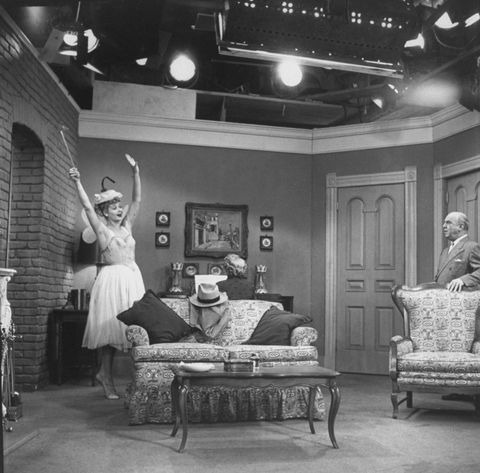
Viewers typically remember 4A as ‘the apartment without the window’. The Ricardos are given a 99-year lease and become fast friends with their landlords.

Ethel luxuriates in Lucy’s brand-new living room furniture won at the Home Show.

In “New Neighbors” (1952) there is a window in the living room where Lucy and Ethel watch the moving vans unload. This window is technically in the set’s “fourth wall” and is never seen again.

The kitchen had a breakfast bar that serves as a chalk board for one of the unruly Hudson twins in “The Amateur Hour” (1952). Sometimes this breakfast bar was skirted and the folk rooster pattern could not be seen.
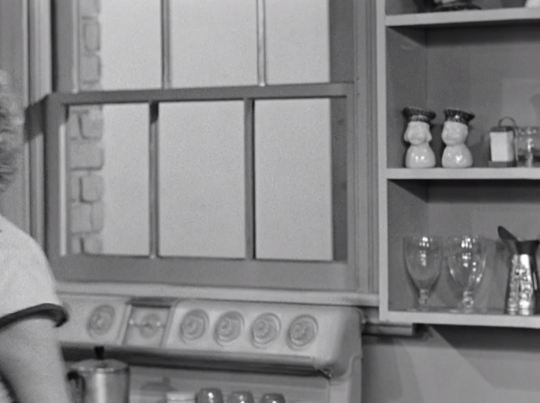
In “The Fur Coat” (1951) the view of the city outside the kitchen window suddenly disappeared!

The bedroom during rehearsals for the first episode filmed “Lucy Thinks Ricky is Trying to Murder Her” (1951) - as yet undecorated! The first scene of the first episode filmed takes place in the Ricardo bedroom. The bathroom was located directly behind the bed, and was accessible through Lucy and Ricky’s closets, on each side of their bed. During this period, the couple’s single beds were generally pushed together. After they had a child, it was thought unseemly so the beds were separated.
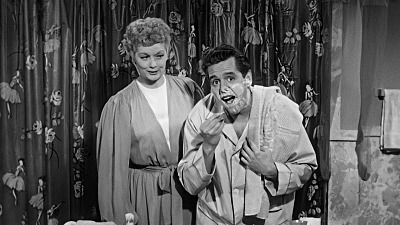
We see the bathroom of 4A only once - in “The Audition” (1951). The un-aired pilot also had a scene set in the bathroom, so this episode followed suit. Part of the scene in the bathroom was deleted for syndication because Lucy holds up a pack of Philip Morris cigarettes when talking about how a girl can even smoke a sponsor’s product. The DVD restores the scene. Although the bathroom was referenced in “Breaking the Lease” (1952) it was not seen.
#2) Lucy, Ricky & Little Ricky Ricardo, 3B / 3D
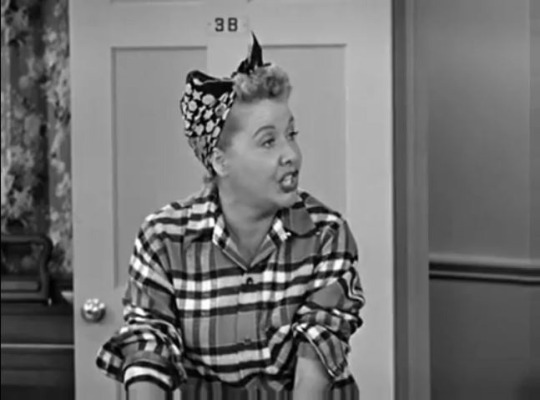
With the birth of Little Ricky, Lucy convinced Ricky they needed to move to a larger (and more expensive) apartment. In “The Ricardos Change Apartments” (1953), Lucy convinces Mrs. Benson, who just married off her daughter to a nincompoop, to switch apartments with them.

The Benson (soon to be Ricardo) apartment is 3B. It has a picture window and space for a nursery!

The change was because in “Lucy Tells the Truth” (1953) Lucy feels the need to embroider her show-business resume. She tells the casting director that she appeared in 3D. When he asks is that is short for “third dimension” (a film trend that was popular at the time), Lucy reluctantly admits that it is merely her apartment number. For the sake of this gag, the Ricardo apartment was re-numbered 3D. It stayed 3D for the rest of the series. Above, Ethel poses in the doorway of 3D in “The Charm School” (1954).

The apartment has been faithfully recreated at The Lucy-Desi Museum in Jamestown NY.

They even decorate it for the holidays, just as it was seen in the “I Love Lucy” Christmas Special (1956).

The bedroom as seen in “Lucy is Envious” (1954). After the birth of Little Ricky, it was deemed inappropriate for the Ricardos to sleep in the same bed, lest viewers make they unseemly connection of how the child was created!

Ricky likes to sing in the shower. We see the Ricardo’s 3D bathroom twice - in “Bonus Bucks” (1954) and “Little Ricky Plays the Drums” (1956). Interestingly, the entire layout of the bathroom changed in those two years. Naturally, the only thing we don’t see is the toilet!
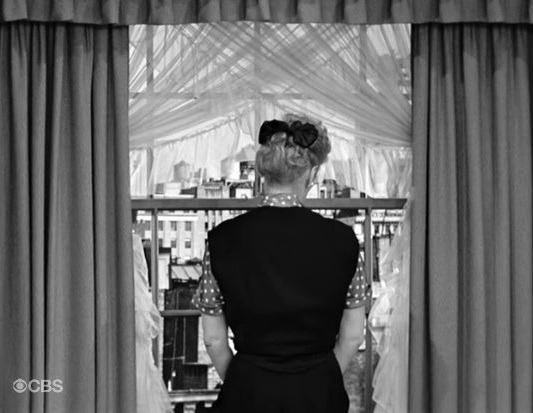
In “Lucy Hates to Leave” (1956), Lucy says goodbye to 623 before moving to Connecticut. Curiously, of the memories she shares about the apartment, a couple are of apartment 4A.
#3) Mrs. Matilda Trumbull

Mrs. Trumbull (played by Elizabeth Patterson) lives with her cat on the 5th floor, although her exact apartment number is never stated. The character appeared in 10 episodes from seasons 2 through 6. Presumably a widow, we meet her nephew Joe (a washing machine repairman) and hear about her sister.

At first, she is adversarial with the Ricardos, but soon warms up to them, becoming their de-facto babysitter. Her favorite expression is “Oh, nuts!” Her favorite perfume is My Sin.

While the Mertzes were in Hollywood and Europe, Mrs. Trumbull managed the building for them. Much to Fred’s chagrin, she kept the building “nice and warm.” A Rudolph Valentino fan, she has some hidden show business aspirations.
#4) Mrs. Benson, 3B / 4A

Mrs. Benson (played by Norma Varden) lives with unseen Mr. Benson (”Meh!”) and has just married off her daughter to a nincompoop. Because of this, Lucy reasons that she has no need for such a large apartment and convinces her to change switch with her.
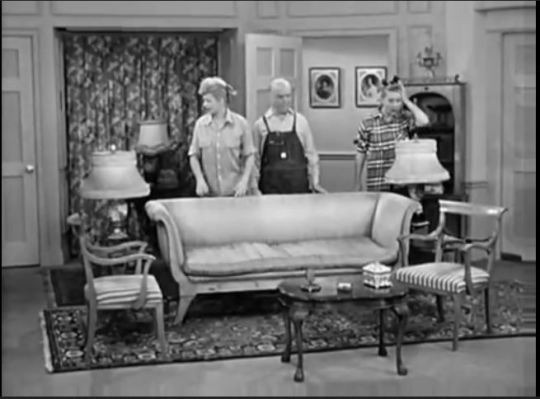
When “The Ricardos Change Apartments” (1953) we get our first glimpse of the living space that the Ricardos will inhabit until they move to Connecticut. Noticeably different than how it looks after the ‘swish’ (as Ricky calls it), the Bensons keep the drapes drawn and have a lot of furniture crowded onto an area rug.

Although Mrs. Benson only appears in one episode, she is mentioned in “Lucy Gets Her Eyes Examined” (1953). Lucy sends Ricky to the drug store for some ice cream, but he returns quicker than Lucy expected after borrowing some from Mrs. Benson. He catches Lucy and the Mertzes ‘auditioning’ for their guest, producer Bill Parker and is not happy about it!

In “The Business Manager” Lucy takes on the marketing for the entire building to pay her bills. She rattles off a list of her ‘clients’: “Benson, Williams, Trumbull.” Interestingly, no tenant named Williams ever appeared on the series. If the writers had longer memories, they might have mentioned Miss Lewis, who lived at 623 (see #8 below).
#5) The Johnsons, 4B

In “Oil Wells” (1954), Sam and Nancy Johnson (played by Sam Cheshire and Sandra Gould) move to 623 from Texas and they are in oil. (LUCY: “Hair, suntan, cod liver, or castor?”). Ricky is suspicious, thinking they may be frauds.
RICKY: “If he’s a millionaire, what’s he doing living in a dump like this?”
FRED & ETHEL: “Dump!?!”
RICKY: “Yeah, to a millionaire, this is a dump!”
FRED: “I accept that.”
#6) The O’Briens, 4B

Tom O’Brien (Hayden Rorke) and his wife (K.T. Stevens) are actors who move into 4B, the same apartment that will be rented by the Johnsons two years later. In “New Neighbors” (1952), they are renting the apartment while making a spy television show.
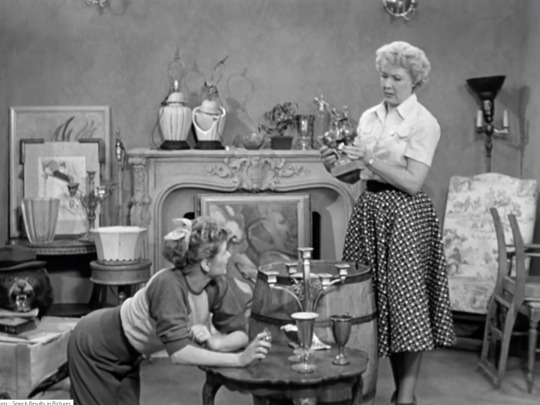
Nosy Lucy and Ethel enter their apartment while they are away to ogle their belongings. Lucy gets trapped in their closet when they come back unexpectedly. They promptly move out!
#7) The Taylors, 3D
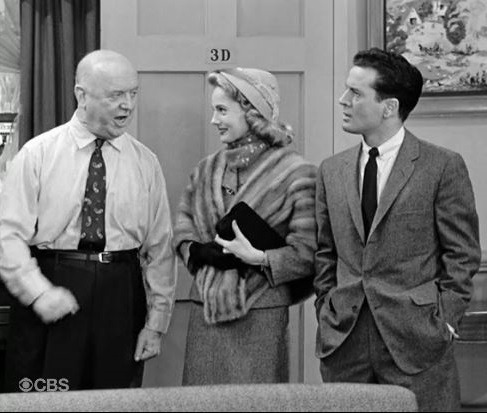
When Lucy and Ricky are about to move to Connecticut, “Lucy Hates to Leave” (1957), but Fred wastes no time in showing their apartment. The new tenants are a young couple named the Taylors (played by Gene Reynolds and Mary Ellen Kay). Selling their furniture to the new tenants, Lucy is horrified to learn that Mrs. Taylor wants to use her own lampshade, paint the coffee table black, and saw the legs off the sofa. Lucy ends up buying most of her furniture back, rather than see it ruined.
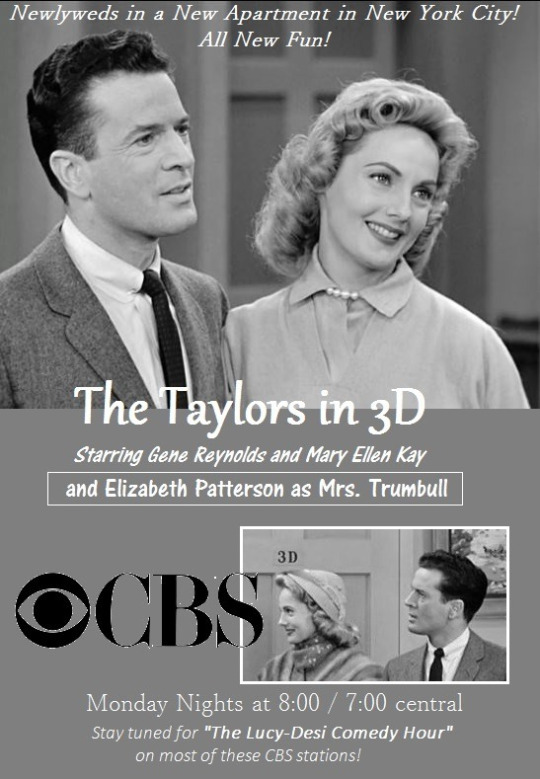
If Desilu made a spin-off...
#8) Miss Lewis, 1A

In “Lucy Plays Cupid” (1952) an elderly spinster (played by Bea Benadaret) is enamored of the local butcher, Mr. Ritter. Lucy plays matchmaker, only to discover that the amorous butcher is sweet on her instead! Miss Lewis enjoys elderberry wine, lace doilies, and gumdrops.
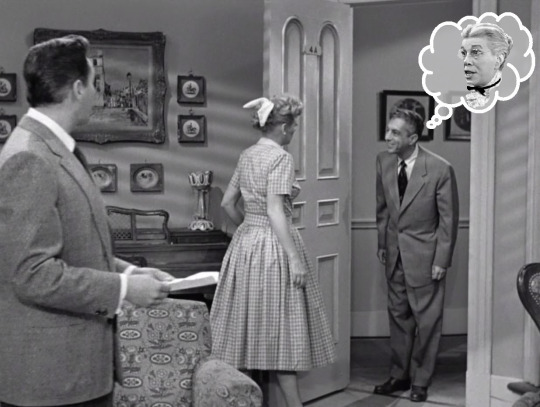
Although this was the only appearance of Miss Lewis, she was mentioned twice in “The Courtroom” (1952). A process server pretends to be looking for “the Lewis apartment” and it is also mentioned that Miss Lewis has baked the Mertzes an anniversary cake.
Bill & Grace Foster
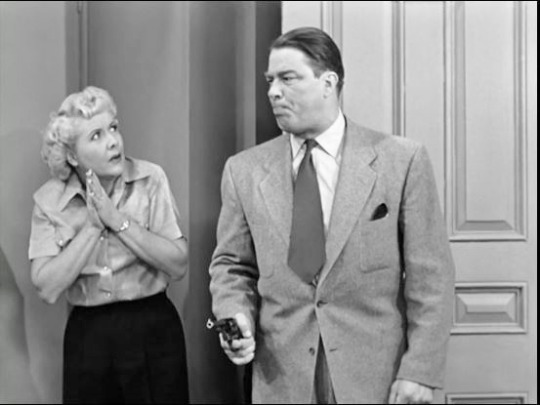
Uniquely, husband and wife Bill and Grace Foster are tenants of 623, although both are seen in different episodes! Bill Foster (played by Richard Reeves) is seen in “The Gossip” (1952) and “The Publicity Agent” (1952).

Grace Foster (played by Gloria Blondell) is seen in “The Anniversary Present” (1952). Grace works for a Josef Jewelry and Ricky wants to by wholesale pearls for Lucy. Lucy thinks Ricky is cheating with Grace and disguises herself as a painter to spy on them. Trouble is - brownstones like 623 were rarely painted - let alone white!
Mr. Stewart

When “Little Ricky Gets a Dog” (1957), the barking upsets grouchy new tenant Mr. Stewart (played by John Emery). Forced to choose between his namesake pooch and surly Stewart, Fred the landlord returns Stewart’s deposit - $200 - then promptly faints!
Herbert & Martha

In “Lucy and Superman” (1957) Fred is anxious to rent apartment 3B next door to the Ricardos. They show it to a nice couple named Herbert and Martha (Madge Blake and Ralph Dumke). Martha is prone to dizzy spells. When she sees something on the ledge, Herbert decides they should look at some basement apartments instead!
HERBERT: “Was it a bird?”
MARTHA: “No.”
HERBERT: “Was it a plane?”
MARTHA: “No.”
HERBERT: “Well, what was it, dear?”
MARTHA: “It was Superman!”

3B has the same view out the window as the Mertz kitchen (3C) in “Never Do Business with Friends” (1953).
~ VISITORS, GUESTS & SUBLETS ~
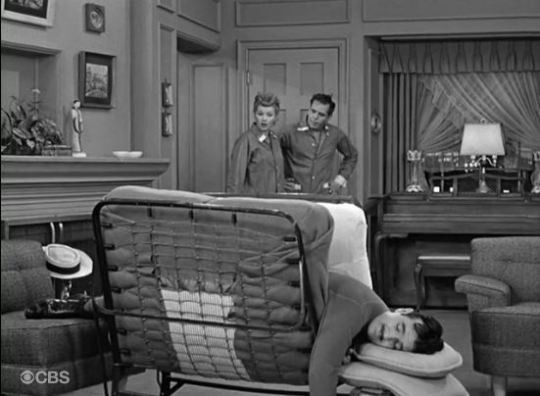
“Tennessee Ernie Visits” (1954) features country music singer and comedian Ernie Ford as a friend (of a friend) of Lucy’s mother’s best friend, who stays.... and stays. After hearing that ‘Cousin’ Ernie is headed to NYC, Ricky moans that they have already had three visitors this month but doesn’t say who they were.
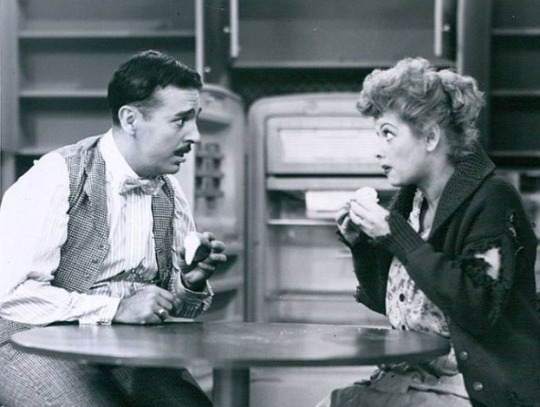
Their extended houseguest eats them out of house and home in “Tennessee Ernie Hangs On” (1954).

When Ricky gets a summer booking in Maine in “The Sublease” (1954), he decides to sublet their apartment. When the job falls through, they must figure out a way to get rid of their nervous new tenant, Mr. Beecher (Jay Novello), a witness at a recent murder trial. The rent on the Ricardo apartment is just $125, but real estate agent Mrs. Hammond knows she can get $300.
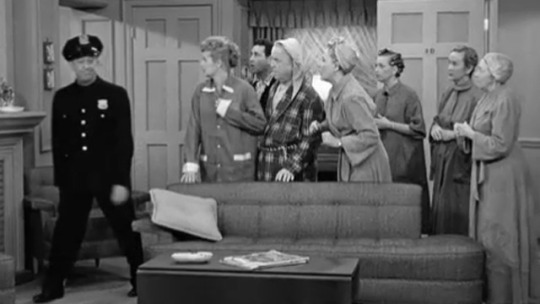
When burglar Madame X strikes in “Too Many Crooks” (1953), a policeman is accompanied by other tenants of 623, all in their nightgowns and pajamas, including Mrs. Trumbull (Elizabeth Patterson). Lucy and Desi’s camera and lighting stand-ins Hazel Pierce (second from left) and Bennett Green (behind Lucy and Fred) are also there, along with Vivian Vance’s camera and lighting stand-in Renita Reachi (3rd from left).
~ NEIGHBORS ~
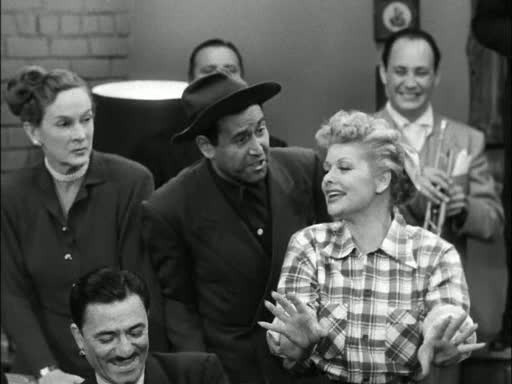
In “Breaking the Lease” (1952) Ricky’s impromptu jam session attracts neighbors like Hazel Pierce and Bennett Green, who were Lucy and Desi’s camera and lighting stand-ins.
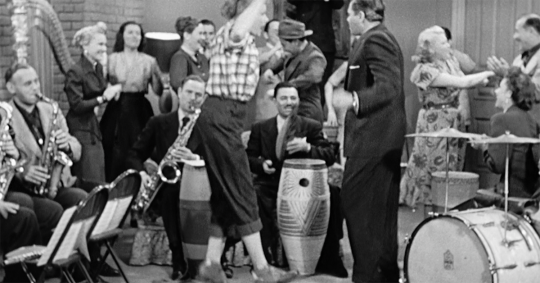
Also (getting the last ticket) is Ball’s Goldwyn Girl pal Barbara Pepper, as well as Ball’s future “Lucy Show” stand-in Joan Carey.

Lucy and Ricky’s “Homecoming” (1955) from Hollywood brings out many of the neighbors for a block party. Those waiting at the stoop of 623 include Lucille Ball’s friend and frequent extra Barbara Pepper, Desi’s camera and lighting stand-in Bennett Green, Lucille Ball’s future stand-in Joan Carey, as well as Roy Schallert, Dick Cherney, and mother of the twins playing Little Ricky, Eva Jean Mayer.

A select group of friends and neighbors are invited inside, including Hazel Pierce (left), and Madge (played by Charlotte Lawrence).
When “Lucy Cries Wolf” (1954), across the street neighbor Mrs. Devries (played by Beppie Devries), telephones Ricky to report that his missing wife is on the ledge!
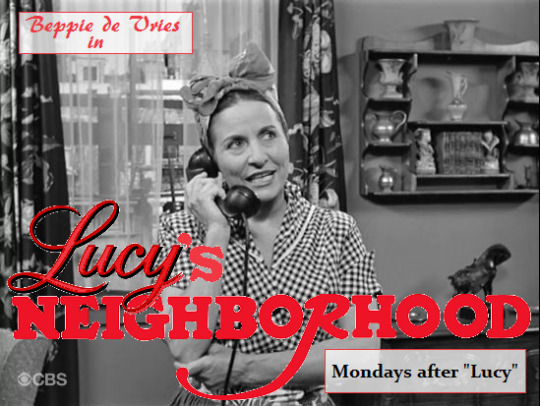
If Desilu did a spin-off...

In “Redecorating” (1952), the Party Line Gossips are played by Florence Halop and Margie Liszt, whose character is referred to as Agnes. Party lines depended upon the users living in the same telephone exchange.
Some unseen tenants and neighbors:
Mr. Benson in “The Ricardos Change Apartments” (1953).
Mrs. Trumbull’s Sister, who takes over the running of 623 when Fred and Ethel move to Connecticut.
In “The Anniversary Present” (1952), Lucy and Ethel go to the basement to listen at the furnace pipe (”the snooper’s friend”) and hear the voices of the couple in 4B (“Albert!”) are not credited but sound like Barbara Pepper and Richard Reeves, two character actors that appeared in many episodes during the series.
In “The Business Manager” (1954), Lucy rattles off the names of several tenants she shops for, including “Williams”.
#I Love Lucy#Lucille Ball#Desi Arnaz#William Frawley#Vivian Vance#TV#CBS#623 East 68th Street#Apartment Building#Tennessee Ernie Ford#Hayden Rorke#Mary Ellen Kay#Elizabeth Patterson#Beppe Devries#Hazel Pierce#Charlotte Lawrence#Joan Carey#Barbara Pepper#Bennett Green#Renita Reachi#Ralph Dumke#Madge Blake#Jay Novello#John Emery#Gloria Blondell#Bea Benadaret#Gene Reynolds#Sam Cheshire#Sandra Gould
19 notes
·
View notes
Photo










women through history | asian americans
#women through history#asian americans#i will probably make a second part#history#patsy matsu takemoto mink#chien-shiung wu#maggie gee#hazel lee#susan ahn cuddy#anna may wong#kalpana chawla#mine okubo#ellen bepp#jadin wong#kieu chinh#myedit#mine#aesthetic#graphics#powerful women
220 notes
·
View notes
Text
50 YEARS OF GOING TO SHOWS, Pt. 5: The Anglo-Celtic-HILLBILLY Connection
As it usually does, it starts with a guitar player, somebody doing something amazing that I THINK I understand. As with the concerts of my rock'n'roll beginnings--Johnny Winter, Jimmy Page, Eric Clapton and then, Jorma, Dickie Betts, Garcia, on to Warren Haynes and Derek Trucks, my way into traditional American folk music was a flat picking guitarist.
My original concert pal said, "Come up to Lawrence (where he and many other good friends went to college at KU), I've got you a ticket for Norman Blake." Sure, that guy from those Dylan albums ("John Wesley Harding" and "Nashville Skyline"), okay. Bluegrass was barely on my horizon and country was but negatively, very negatively. Blake was probably on his first or second solo tour (his St. Louis show at Wash U is a legend around town) and he was all piss and vinegar, pure flash, bringing the gospel of Doc Watson (I later found out) to us hippies. He was amazing, so much sound from one guitar, basically from one line. Within chord shapes, he was playing amazing melodies (fiddle tunes) that had complexity and coherence and variation. If I hadn't seen it, I would have sworn there were more people than just him. But it was just him. I was an acoustic player, a strummer who didn't really know about fingerpicking, but this was from outer space. It really stayed there too, I'm afraid.
Blake was on my radar--but just vaguely. It took being Focal Point regulars to develop a context and to get another chance. Norman was yet another friend of Judy and Eric and he did a special fund raising show for us at Music Folk (50 or so people in with the instruments resonating with us); there was another show, maybe the next night, maybe another tour, at the actual building in Maplewood. He was so solid, so tasteful, so seemingly ancient with original songs no less. He only occasionally put on the after burners (and for that I was more disappointed than I should have been), but there was lots of music there.
By then I'd discovered Doc Watson who did always remind you that he could, well into his 70s, flat out play with stunning fiddle tunes and tasty little fills in the actually ancient songs he sang. There were two shows at the Sheldon Concert Hall, utterly captivating. But what was even better was when we made a vacation of the 2001 National Folk Festival in East Lansing, MI, where he did two full blown sets and some workshops, including one with several acolytes. The one who stood out was David Doucet from Beausoleil who turned Cajun tunes into flat pick tunes. There was lots of great music there, including Barrachois from Prince Edward Island, but I wanted to soak up as much Doc as I could.
He was a treasure and was one work pals nominee for the most important American musician (yes, ahead of Duke Ellington, Jimi Hendrix, Charlie Parker, Bill Monroe, and well see that was the problem is it BB King or Muddy Waters or Robert Johnson or...). I do think he's in there for remaking the music through elevating the guitar and keeping a key tradition alive.
Focal Point brought in other pickers, including Dan Crary (flashy but a real student) and David Grier (technique but that's about it) and, intriguingly, Beppe Gambetta who also had technique galore and the unique love an outsider can bring but also an original conception with amazing revoicings of tunes ("Church Street Blues," "Plains of Waterloo") that became jazzy while staying grounded.
Ah, guitars.
There have also been blues players at Focal Point. Dave Van Ronk and Geoff Muldaur have long standing 1960s Folk Revival bona fides (and therefore great stories), but let me also include Andy Cohen as yet another direct student of the Reverend Gary Davis. A thorough acolyte, Cohen, a nice Jewish boy presumably, played more of the religious songs than the blues, picking hard on a big old Gibson. His singing is also street preacher aggressive. I like the others more, but he’s a friend of the Steins, so I’ve seen him at some close range and appreciate him keeping alive the tradition.
Van Ronk as the Mayor of Macdougal Street also knew Davis and others. He was there to welcome Bobby Zimmerman when he got to town from Minnesota. His singing was at once gruff, gentle, and wry with very solid right handed finger picking. He helped Davis get to gigs in Boston from New York and recalls him sleeping and playing at the same time the whole way. I also try to play “Sporting Life Blues” because of his story about this tale of dissipation and world weariness that he got from Brownie McGee. He showed it back to him and asked how old was he when he wrote it? 23. Van Ronk had all that history, a fondness for spinning such yarns, and a great ease at being at Focal Point.
Muldaur revived his career on either side of the Millenium with some nice finger picking, a nice grasp of the repertoire, and a subtle voice. He’d been up in Boston with Jim Kweskin but also had stories. The best one was about a late party with John Hurt where after a time some marijuana appeared. It took a couple of circuits of the joint for Muldaur to notice that Mississippi John was taking his turn too. “Did you all have reefer in Avalon, John?” “Oh sure, all the time....But when we had money, we drank gin.” I’m glad I’ve got this link to the heritage.
He is now The Tom Hall, but we saw this local hero with his National Standard Resonator guitar at Focal Point but also at bookstore gigs. He too knows a broad blues repertoire and has been around town through thick and thin for years. He was in the Geyer Street Sheiks with my former guitar teacher Steve Mote and the bulk of the rest of the band became the Flying Mules who were a great jamming swing band with Marc Rennard leading the way on fiddle. I got to see Mote up close even as ill health and a generally anxious situation closed in on him. He was supremely talented with huge ears, giving me a broad palette of guitar technique in blues finger picking, Celtic, flat picking, jazz chords, even some Bach. I was eager for all of it and sure did appreciate Steve’s wide enthusiasms.
Mike Seeger was another friend of Focal Point. I saw him once and Ellen and Sam saw him another time on May 19, 1996, so Seeger lead the Happy Birthday for Sam. There were different stories and different roots and the aesthetic of the country dance, not quite as earnest as his older half brother (who I didn’t ever see), but distinctive and welcoming. Seeger’s New Lost City Rambler counterpart, Tom Paley, also played Focal Point a few times. He was twitchy and cranky, sort of professorial too but coasting with tenure more than just being a natural teacher.
If we didn’t see Pete Seeger, we got Sam to see Arlo Guthrie once, maybe twice. Certainly at the Sheldon, possibly at an outdoor concert. Arlo sure has stories but he backs it up with a mix of fine playing and an encouraging manner with young players, including his kids.
St. Louis is a strong old time town with an equally active contra dance community. I’ve mentioned Marc Rennard from the Sheiks already, but he is one of a first tier that also includes Geoff Seitz, once with the Ill-Mo Boys with Jim Nelson and Curtis Buckhannon. Mote was in the Goney Boat Band and there have been ongoing iterations. It is out of a general 20s-30s vibe stretching back at least to the Sheiks that create the tradition that Pokey LaFarge comes out of. So that’s been floating around in my local music experience.
John Hartford had St. Louis roots, so we got to see him including when he was sick. I recall both a solo show and a later one with his string band around a single mic. Both were transcendent with strongly rooted tunes and off handedly brilliant playing, mostly fiddle, but then those oh so smart songs of his.
Sam Bush is a Cardinals fan, so I’ve got to see him play a couple of times and will again. He is such an enthusiastic and fluid soloist. He is definitely new grass, so he has a distinctive and original sound. But he is the Sonny Rollins to Grisman’s questing on his own terms John Coltrane on the mandolin, We saw Grisman on the tour to support his Klezmer album with some members of his band, the legendary drummer Hal Blaine, and not Andy Statman. I’m glad to have seen him ande value all he has done, but Bush is easier.
But I wrap up with the remarkable Bruce Molsky who I will see anytime he comes to Focal Point. He is rock solid and brings a distinctive old time fiddle, guitar, banjo, and singing to any project. He’s only been solo or, two weeks ago, with a string band. He has Metis tunes, rachenitsas, a Joseph Spence tune, from his albums, but he is right there with the likes of Aly Bain and Ale Moller when they incorporate his music with Swedish and Shetlands or with Andy Irvine in a old time/Irish/Balkan mash up or with Finnish musicians like Arto Jarvela and Anon Engelund. He is so welcoming, so interesting by being so interested.
That’s what the music is supposed to do.
1 note
·
View note
Text
24 de março
Bom dia a todos!...
Neste dia:
Nasceu, em 1926, o grande escritor italiano Dario Fo.
Nasceu, em 1938, a ótima cantora brasileira Ellen de Lima.
Nasceu, em 1960, a linda modelo e atriz estado-unidense Kelly LeBrock.
Helenice Teresinha de Lima Pereira de Almeida, a Ellen de Lima nasceu em Salvador, no dia 24 de março de 1938. É uma cantora e atriz brasileira que fez sucesso durante o período dourado do rádio, na década de 1950. Tornou-se conhecida do público por ser a intérprete da célebre "Canção das Misses", escrita por Lourival Faissal, para servir de tema do tradicional concurso de Miss Brasil. Atuou bastante em televisão (trabalhou como atriz-cantora na TV Globo, ao lado de Fernanda Montenegro e Sérgio Britto) e em diversas boates, como a Oásis paulistana e O Galo, no Rio de Janeiro, além de participar de espetáculos no Copacabana Palace, ao lado de Haroldo Costa e das Irmãs Marinho.
Kelly Marie LeBrock nasceu em Nova Iorque no dia 24 de março de 1960. É uma modelo e atriz norte-americana. É mais conhecida pelos filmes The Woman in Red (A Dama de Vermelho) e Weird Science (Mulher Nota 1000). Foi casada de 1987 a 1996 com o ator Steven Seagal, com quem teve três filhas: Annaliza (nascida em 1987), Dominick (1990) e Arissa (1993).
Dario Fo nasceu em Sangiano no dia 24 de março de 1926 e morreu em Milão em 13 de outubro de 2016. Foi um escritor, dramaturgo e comediante italiano. Recebeu o Nobel de Literatura de 1997. Durante a indefinição política após as eleições parlamentares de 2013 Fo foi indicado para concorrer ao cargo de Presidente da Itália pelo líder do Movimento 5 Estrelas (M5S), o ex-comediante Beppe Grillo. Entre suas obras estão "Mistero Buffo" (1969) e "L'Anomalo Bicefalo" ("O Anômalo Aicéfalo", em tradução livre), de 1999.
Uma de suas obras mais conhecidas é, sem dúvida, "Morte Acidental de um Anarquista" (1971). Ela foi traduzida para vários idiomas e também foi adaptada em peças de teatro pelo mundo, sendo sua obra mais reproduzida pelos palcos. O livro tem como base fatos reais, mas através da comédia traz questionamentos sobre a vida e a organização em sociedade. A obra se baseia na morte do anarquista milanês Giuseppe Minelli, que foi acusado de participar de atentados terroristas na cidade e que teria "se suicidado" - jogando-se do prédio da delegacia da cidade em 1969. Usando muita ironia e sarcasmo, Fo ambienta a história na busca policial por um suposto "doente mental", que assume diversas identidades. Ele teria "provas" de que o suicídio de um anarquista foi, na verdade, um assassinato cometido por policiais. A peça de teatro e consequente livro sobre a trama causou mais de 40 processos contra o escritor que, para evitar mais problemas, adaptou a obra para ambientá-las nos Estados Unidos, mais precisamente na Nova York da década de 1920, onde um fato semelhante ocorreu com Andrea Salsedo.
Posto hoje:
Ellen de Lima interpretando Gente Humilde de Garoto, com letra de Vinícius e Chico. Cara, é lindo...
Ellen de Lima interpretando "Hoje" de Taiguara. Cara, uma linda canção...
Trailer de The Woman in Red (A Dama de Vermelho). É um filme de 1984, dirigido por Gene Wilder, com ele e com a Dama de Vermelho Kelly LeBrock.
Kelly LeBrock, “The Dream Girl of The 80s”. Na época e agora.
0 notes
Text
Róma fellázad Brüsszel ellen: formálódik az új olasz koalíció
Határozottan euroszkeptikus álláspontja lesz az új kormánynak
Minden jel szerint a korábban teljesen “koalícióképtelennek” tartott olasz Öt Csillag Mozgalom (M5S) és a Matteo Salvini vezette Északi Liga már csak egy karnyújtásnyira van a koalíciós szerződés aláírásától. Brüsszelben nyilván sokan idegeskednek: Salvini néhány engedményért cserébe euroszkeptikus hangsúllyal tervezi az új kormány programját – legalábbis a La Stampa olasz lap szerint.
A kiszivárgott információk szerint a koalíciós szerződés javaslata tartalmazza Olaszország kiléptetését az eurozónából. Erre reagálva Salviniék azt nyilatkozták, hogy egy néhány nappal ezelőtti javaslatról van szó, az újban nem terveznek semmilyen „italexitet”. Mindenesetre a szövegezés nagyon sokat elárul a tárgyalások hanghordozásáról.
Többek között az is sejthető belőle, hogy az új olasz kormány konkrét követeléseket támasztana az Európai központi Bankkal szemben – például, hogy fagyasszák be az olasz adósságot 250 milliárd eurónál.
A média sejtései szerint az Unióval szembeni hangnemet Salvini fogja meghatározni, cserébe az M5S adhatja az új miniszterelnököt – vagy a 31 éves pártvezető, Luigi di Maio, vagy a párt egy másik személyisége szerezheti meg a kormányfői széket. A választási félidőnél azonban a stafétát át kellene adnia az Északi Liga kormányfőjelöltjének.
Az új olasz kormány várhatóan megszünteti az oroszokkal szembeni szankciókat is. A M5S alapítója, Beppe Grillo a Newsweek amerikai portálnak nyilatkozva azt mondta:
„Egyáltalán nem tartok Putintól. Ő üzletelni akar, nem háborúzni. Az antiputinizmus az szankciókon keresztül nekünk 1 milliárd eurónkba kerül”
fogalmazott. Hozzátette, hogy bár szeretne népszavazás Olaszország eurozónás tagságáról, de szerinte jobb megoldás lenne, ha két euró létezne: egy az északi országoknak, egy délieknek.
Postoj.sk
Nyitókép: LaStampa.it
0 notes
Text
Üdv a klubban, Angela!
Drámai! Történelmi! Efféle hangzatos jelzőkkel kommentálja a világsajtó a német választást. Valóban történtek kimondottan érdekes, az eddig igen unalmas belpolitikai élet felpezsdülését hozó változások. Mindenekelőtt az, hogy a nagy pártok kárára az eddiginél szegmentáltabb lett a politikai paletta. A harmadik legnagyobb erőként bejutott a Bundestagba a jobboldali-populista Alternatíva Németországnak (AfD). Nyolc százalékot vesztettek a négy évvel ezelőtti eredményükhöz képest az Angela Merkel mögött álló uniópártok, míg a nagykoalíció másik lábát képező szociáldemokraták minden korábbinál rosszabb eredményt értek el, így a további erodálódást elkerülendő ellenzékben képzelik el a közeljövőt. A CDU–CSU számára így az eddig csak tartományi szinten kipróbált Jamaica-koalíció marad, amelyben négy párt szempontjait kell összefésülni.
Megannyi újdonság – de a drámai, sőt a történelmi jelzők erősen túlzók. Nem történt más, mint hogy Németországot is elérték az európai trendek. Akárcsak Hollandiában, Ausztriában vagy Franciaországban, itt is visszaestek a hagyományos nagy pártok, és – a sort folytatva – Nagy-Britanniához, Olaszországhoz, Svédországhoz, Magyarországhoz, Lengyelországhoz vagy éppen az Egyesült Államokhoz hasonlóan megerősödött a jobboldali nacionalizmussal vegyes populizmus. A sötét, XX. századi múlt, a véget nem érő vezeklés miatt ez Németországban furcsa, és az alapvetően liberális sajtó már a vészharangokat kongatja, ám kívülről nézve csak annyit mondhatunk, hogy üdv a klubban, az európai fősodorban.
http://mno.hu/
Vegyük a szélsőségektől sem mentes jobboldali populizmus áttörését. Mielőtt azonban az AfD-t sokakhoz hasonlóan lenáciznánk, emlékeztessünk arra, hogy az általuk megütött hang immár nemcsak Magyarországon, de a demokrácia bölcsőjének tartott Amerikában is mindennapos. Ez nem szép, de tudni kell, hogy az AfD csak – Orbán Viktorhoz, Beppe Grillóhoz vagy Donald Trumphoz hasonlóan – a polgároknak a globalizáció negatív hatásaival és a bevándorlással szemben felerősödött félelmeire épít. Az eurókritikával indult, majd a migránsválsággal igazi lendületet kapott párt képében ráadásul a radikálishullám minden szélsőséges kilengés ellenére is amúgy németesen, az európai átlagnál puhábban érte el Berlint. A kiábrándultság errefelé inkább a pluralizmus kiteljesedését hozta. Ha már itt tartunk, érdemes felhívni a figyelmet arra, hogy közben a már sokszor eltemetett liberális világnézetet képviselő szabad demokraták 10 százalék feletti eredménnyel tértek vissza a Bundestagba. Ez akkor is érdekes, ha a piacpárti FDP migránsügyben nem riadt vissza az AfD-ére rímelő szólamoktól.
Vagy nevezzük ezt inkább realizmusnak? Igen: mert a szociális igazságosság mellett a belbiztonság volt a kampány slágertémája. A Bild felmérése szerint a terrorizmus megfékezését és a bűnözés visszaszorítását a megkérdezettek 69-69 százaléka tartotta fontos kérdésnek. Egy népszavazás esetén ma a németek 48 százalék szavazna a bevándorlás szigorítása mellett, 46 ellene, miközben menekülteket 90 százalék továbbra is befogadna. Mindez Magyarországról nézve furcsa lehet, ám német viszonylatban ez a korábbi nyitottság érezhető csökkenését mutatja, különösen a gazdasági okokból érkezők tekintetében. A trenddel minden pártnak számolnia kell, ám hogy az egytémás AfD-nek még lehetnek gondjai, azt jelzi, hogy a bevándorlás korlátozását csak a németek 29 százaléka tartja kiemelten fontos kérdésnek. Bajba is kerülhet tehát az AfD, ha a következő kormány csendben tovább zárja a kapukat.
http://mno.hu/
http://mno.hu/
Népszerű ezekben a napokban Merkel pirruszi győzelméről beszélni. A CDU–CSU 33 százaléka 1949 óta tényleg a második legrosszabb eredmény, ám az egyértelműen csökkenő trendből, a 35 százalék körüli átlagból valójában a négy évvel ezelőtti 41,5 százalék lóg ki. Ha ehhez hozzávesszük, hogy Merkel 12 évi kormányzás után tart itt, akkor nem is rossz az a 33 százalék. Érdemes ráadásul az eredményt onnan is nézni, hogy két éve a kancellár hatalmasat hibázott migránsvonalon, és onnan hozta vissza megrendült népszerűségét. Ne felejtsük el, hogy az év elején Martin Schulz SPD-je majdnem beérte az uniópártokat – és akkor még nem beszéltünk arról, hogy miként szerepeltek a hagyományos nagy pártok mondjuk Franciaországban.
Minden viszonylagos tehát. Angela Merkel elsősorban a gazdaság elismerésre méltó teljesítményének köszönhetően úgy vághat neki utolsó ciklusának, hogy bár kapott egy figyelmeztetést, nem akarták elzavarni. Az új leosztás közben megnehezíti a dolgát, ugyanakkor kreativitásra is sarkallja, ami – magunk között szólva – rá is fér a legendáját építeni szándékozó kancellárra. Aki az európai realitásokkal otthon is szembesülve többé nem nézhet le kollégáira a kivételezettek morális magasságából.
Ennek a cikknek a nyomtatott változata a Magyar Nemzetben jelent meg. A megjelenés időpontja: 2017.09.30.
Üdv a klubban, Angela! a Nemzeti.net-en jelent meg,
0 notes
Text
Euractiv: Soha ne higgy ezután Verhofstadtnak
EURACTIV
Az Euractiv „sorból kilógó” publicistája, James Crisp) kör-emailben szétküldött írásának címe: „Soha az életben ne higgy Verhofstadtnak”.
Volt még idő, amikor ha nem is értettünk vele egyet, legalább hihettük, hogy azért áll ki, amiben hisz. /Crisp nyilván nem a jobboldali magyarokra gondolt./
Tegnap Beppe Grillo Ötcsillagos Mozgalma úgy szavazott, hogy csatlakozik Verhofstadt liberális frakciójához, az ALDE-hoz az Európai Parlamentben.
Verhofstadt pénteken még kijelentette, hogy „küzd a populizmus ellen”, ha január 17-én megválasztják az Európai Parlament elnökének.
Azzal, hogy bejelentette, hajlandó találkozni és így ágyba bújni Grilloval, a populistával, aki ki akarja léptetni Olaszországot az euroövezetből, még ha találkozójuk tegnap kudarcba is fulladt, Verhofstadt megmutatta igazi arcát.
Vagyis Verhofstadt egy elvtelen populista, aki minden meggyőződését hajlandó feladni politikai karrierje érdekében.
Vagyis Verhofstadt egy elvtelen populista, aki minden meggyőződését hajlandó feladni politikai karrierje érdekében.
Megosztás:
Euractiv: Soha ne higgy ezután Verhofstadtnak a Nemzeti.net-en jelent meg,
0 notes